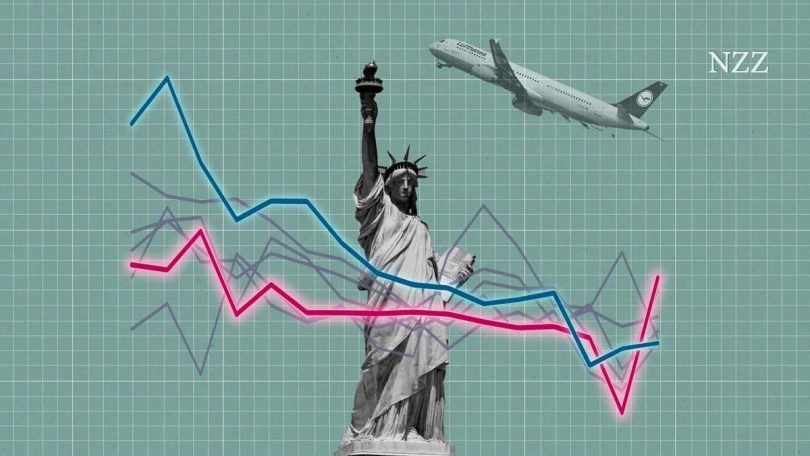Reports of a decline in the number of Western European tourists visiting the U.S. have been premature. However, visitor numbers from other important tourist countries are down – probably for a variety of reasons.
In recent months, the United States’ trade wars and arbitrary arrests of foreign nationals, as well as President Donald Trump’s annexation fantasies, have prompted anger and uncertainty among would-be tourists. A few weeks ago, it seemed as if travelers from Western Europe might be avoiding the United States for some time to come. An analysis by the Financial Times, for example, showed that significantly fewer Europeans visited the U.S. in March than in the same month the previous year.
The Swiss media picked up on the story, writing that Swiss travelers were punishing the U.S. by «withdrawing their affection.» However, recently released figures for April visits to the U.S. now show that the situation is not as bad as it initially seemed, with tourist numbers rising sharply again in that month as compared to April of 2024.
The number of travelers to the U.S. from Germany and Switzerland rose by around 10% in April compared to the same month the previous year, while the number of arrivals from Spain, Italy and Ireland rose by 30%.
However, these fluctuations are likely not linked to political turmoil, but are rather the result of a seasonal effect. Significantly more tourists are always expected in the U.S. over the Easter holidays each year. Last year, Easter was in March, but fell on April 20 this year. The significant fluctuations visible in the data are therefore mainly attributable to Easter tourists, who traveled to the U.S. a few weeks later this year. This change in travel behavior is also reflected in the number of airplane arrivals at major U.S. airports.
For many Western European countries, the U.S. tourism figures for 2025 to date are therefore at a level similar to that seen in previous years. One striking observation is that even more people are traveling to the U.S. from Spain and Italy than was the case before the pandemic. For tourists from Sweden and Denmark, on the other hand, the figures remain well below pre-2020 levels. However, they had already stabilized there in previous years, when Joe Biden was still president.
All this said, a Trump effect cannot be completely ruled out. It is possible that more German and Swiss tourists would have visited the U.S. under a Kamala Harris administration. However, almost no such effect was visible during Trump’s first term in office.
The Trump administration should be far more concerned about visitors from Asia than about Western Europeans. Their numbers have been declining since he took office, although the U.S. Department of Commerce still reported healthy growth rates as recently as last year.
The exceptionally strong growth in early 2024 is partly due to the fact that COVID-19 travel restrictions lasted longer in Asia than in other regions. However, a look at the figures for Asian countries overall reveals worrying trends for the Trump administration: Significantly fewer tourists and business travelers are arriving from Japan and China – the Asian countries which have previously provided the most visitors to the U.S. – than was true before the pandemic. In both cases, a post-pandemic recovery in these figures has flattened this year. However, more people from India are today visiting the United States. Indeed, this population now makes up the largest group of travelers from Asia.
It is unclear whether Trump’s policies are playing a role in dampening Japanese and Chinese tourists’ enthusiasm for U.S. visits. Unlike in the Scandinavian countries, there was no sign in these countries of a similar longer-term stabilization prior to Trump taking office. It is possible that the figures might have recovered even more strongly under a Harris administration.
It is likely that the ongoing trade war may be dissuading many potential visitors from China in particular from traveling to the United States. It is also possible that business meetings have been canceled due to the customs dispute. In Japan, on the other hand, the general desire to travel has reportedly diminished, and the share of Japanese people with passports has declined overall since the pandemic. The weak yen may also be playing a role, as a trip to the U.S. for a resident of Japan is significantly more expensive today than it would have been before the pandemic.
Canadians staying away, Mexicans less so
The largest number of people traveling to the U.S. come either from neighboring Canada or Mexico. The U.S. trade authority’s statistics do not include full figures for March and April for these countries. For Mexico, only those arrivals coming by plane are recorded. This figure has even risen slightly under Trump on a year-to-year basis. However, overland arrivals play a much more significant role in this regard. These were also slightly higher in February 2025 than they were during the same month of 2024.
Canadians, by contrast, seem to be put off by Trump’s tariff policies and his public musings about incorporating their country as the 51st U.S. state. According to the Canadian statistics agency, the number of Canadians returning by land over the U.S.-Canada border fell by 35% in April 2025 compared to the same month last year, while the number of those returning by air declined by around 20%.
Mixed signals for the rest of the year
Whether Trump’s policies will have a lasting impact on travel to the U.S. will become clear only in the coming months. Travelers who booked a trip before Trump took office may not cancel it because of him or his policies. Given the current environment, however, some may decide against a trip taking to the U.S. in the summer or fall.
However, it does seem as if the Swiss are in fact retaining their affinity for America, at least for now. Zurich Airport CEO Lukas Brosi says that demand for travel to the U.S. is on the rise. According to Swiss Airlines, booking figures for the rest of the year are on par with those seen in 2024. However, global demand for travel to the U.S. could well decline in the future. Several hotel chains and booking platforms have scaled back their growth expectations for U.S.-bound travel, and industry experts anticipate a slight decline in overall international tourist arrivals to the United States.
Latest articles
NZZ Geopolitics – The independent Swiss view
Standing outside the American media establishment, the NZZ offers distinctive insights that challenge the polarized narratives often found in U.S. coverage. Our goal is to provide in-depth, nuanced reporting on global affairs, including developments in the United States, Europe, China and beyond. Taking a nonpartisan stance, we approach events with a sober and critical eye. Backed by a trusted network of international correspondents and expert reporters based in Switzerland, we deliver sharp analysis and a deeper understanding of geopolitics and the global economy.
Sign up for our free newsletter or follow us on Twitter, Facebook or WhatsApp.










